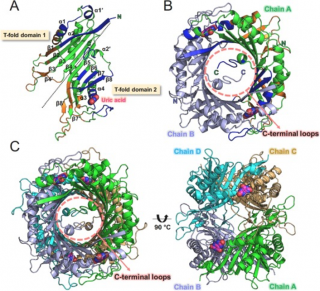Oct, 2021

Microbial urate oxidase has emerged as a potential source of therapeutic properties for hyperuricemia in arthritic gout and renal disease. The thermostability and long-term thermal tolerance of the enzyme need to be established to prolong its therapeutic effects. Here, we present the biochemical and structural aspects of a hyperthermostable urate oxidase (TbUox) from the thermophilic microorganism Thermobispora bispora. Enzymatic characterization of TbUox revealed that it was active over a wide range of temperatures, from 30 to 70 °C, with optimal activity at 65 °C and pH 8.0, which suggests its applicability under physiological conditions. Moreover, TbUox exhibits high thermostability from 10 to 65 °C, with Tm of 70.3 °C and near-neutral pH stability from pH 7.0 to 8.0 and high thermal tolerance. The crystal structures of TbUox revealed a distinct feature of the C-terminal loop extensions that may help with protein stability via inter-subunit interactions. In addition, the high thermal tolerance of TbUox may be contributed by the extensive inter-subunit contacts via salt bridges, hydrogen bonds, and hydrophobic interactions. The findings in this study provide a molecular basis for the thermophilic TbUox urate oxidase for application in hyperuricemia and gout therapy.